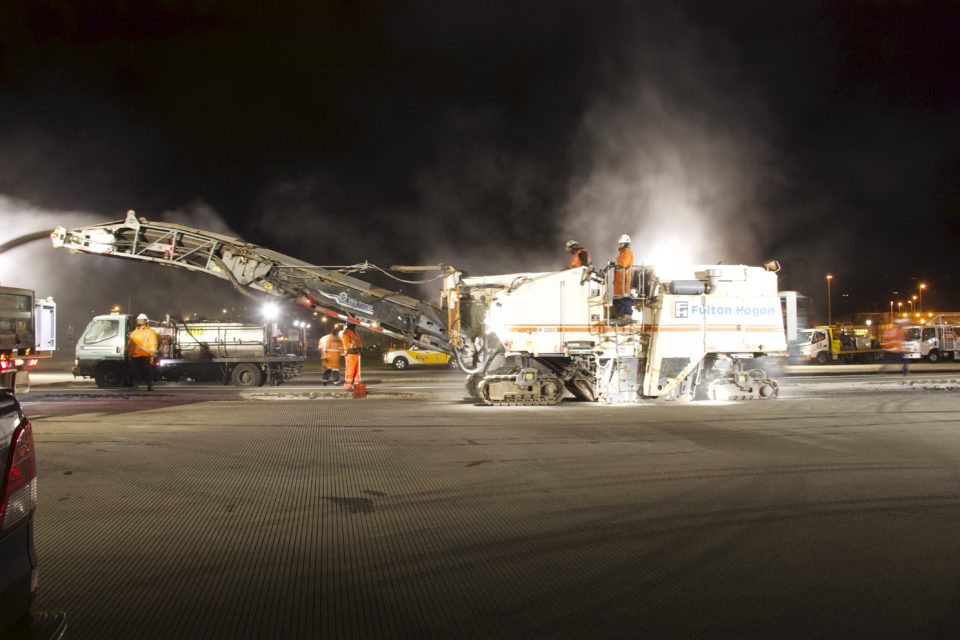The main runway at Wellington Airport is being resurfaced – a project that will take four months as it can only be done at night. Richard Silcock explains.
The 2000-metre-long main runway at Wellington Airport is being completely resurfaced and it will take the contractor, Fulton Hogan, around four months to complete as it is being carried out only at night to avoid disruption to airline services during the day.
Physical works started in mid-September and requires milling and removing the existing runway surface, laying the new asphalt surface, and then grooving it to improve rainwater runoff and aircraft traction.
“Resurfacing of the runway is required every 10 to 12 years as the surface reaches the end of its design life,” says Nick Petkov from Wellington Airport who is managing the project.
“The last resurfacing was done 11 years ago.
“The work was originally scheduled for the summer of 2021-2022, however as there are no late-night international flight arrivals at present due to the border restrictions, we have taken the opportunity to bring the project forward.”
Wellington Airport handles on average 230 scheduled flights per day, he adds, excluding the aero club and air ambulance movements and there were 11 airlines operating into and out of the airport pre-pandemic on a regular basis.
“Having the contractor work at night avoids disruption to airline schedules and it gives them a longer working window resulting in the project being done more efficiently and over a shorter time frame.
“Usually it would take up to six months to complete depending on the weather, so with this shorter time frame it will reduce the cost.”
Fulton Hogan’s surfacing divisional manager, Ben Struthers, says they are working from 10pm through until 6am each night, from Sunday night to Friday morning with a team of between 60 and 70. They also have a team of 15 on a day shift doing testing analysis, scheduling and trucking waste and new material in and out.
“The extended hours also have other benefits in addition to reducing the project time frame, as it allows us to complete longer asphalting runs with fewer joins in the pavement,” says Ben.
“As a result it will be a much smoother surface.
“Working on up to 2800 square metre sections at a time the existing surface is removed using two Wirtgen cold milling machines with a combined number of cutting picks totalling 340 at 15mm spacings.
“This milled material is self-loaded onto trucks as the machines move forward via a conveyor-belt system and taken to an onsite stockpile before being trucked to our storage facility at Seaview, where it is processed into re-usable product.”
Prior to physical works starting, Fulton Hogan worked with paving design consultant Beca on the design and specifications for the asphalt, as the runway is divided into three sections: the southern, central and northern sections and each has a different surfacing specification as it is the southern and northern sections that take the brunt of an aircraft’s landing weight.
The southern (648 metres) and northern (446 metres) sections of the runway will be repaved to a nominal depth of 85mm with polymer modified AC14 high strength asphalt on top of a polymer membrane seal.
For the central 906 metre section, it will be strengthened with 150mm deep lift asphalt patches before a nominal 60mm of polymer modified AC14 asphalt is laid on top of the membrane seal.
The asphalt is being laid using a Vogele MT 3000 offset MTV and Vogele Super 1803-3 asphalt paving machines.
“Having the MTV (material transfer vehicle) is great for a number of reasons,” says Ben.
“It allows us to do continuous paving as there is a reduction in thermal and material segregation and it allows for more asphalt storage on-board, resulting in a uniform and smoother surface.”
A service trench under the runway is also being installed to house electrical lighting and communication cables and the runway surface grooved to aid aircraft traction especially during wet weather.
“The grooving is carried out once the asphalt has fully hardened in around six weeks. It is done using two grooving machines equipped with diamond tipped blades spaced at 38mm centres and each machine cuts 6mm x 6mm groves in the asphalt across the width of the runway.
“The waste material is sucked up by vacuum sweepers with this part of the job taking approximately three weeks to complete.”
In line with aviation safety regulations, after each night shift all machinery and vehicles are removed from the runway and, with the aid of lighting towers, staff form a chain and walk across the runway to closely inspect the surface for any stones or other debris.
In total, 17,000 tonnes of old asphalt will be removed and taken to the storage yards before being crushed and used elsewhere for road projects, diverting tonnes of asphalt from going to the landfill and reducing the need to quarry new aggregate.
As a part of its preliminary work, and in an effort to keep noise levels to an absolute minimum at night, the Fulton Hogan project team received advice from acoustic engineers on ways to minimise noise.
This resulted in all vehicles being fitted with non-tonal reversing beepers, non-vibrating compactors and oscillating rollers, and, where possible, some machinery is fitted with acoustic sound curtains around some machinery.
“We are also manufacturing the asphalt off-site at our Belmont batching plant in the Hutt, staggering truck haulage hours and routes to the airport and stockpiling material on-site to minimise truck movements at night,” says Ben.
Direct communications and a website have been set up to keep local residents informed on the project, which is expected to be completed by late January at a total cost of $13.7 million.


Parting words from Jeremy Sole- a final column